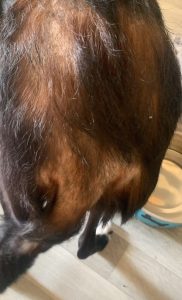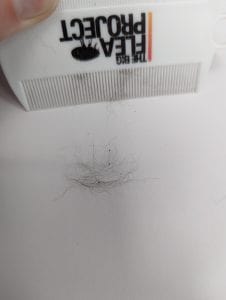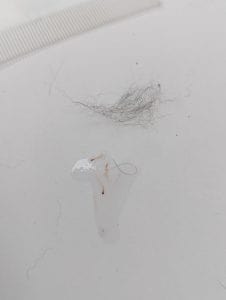Flea allergy dermatitis in dogs is an allergy to flea saliva. Fleas are an extremely common problem for dogs. The symptoms often include extreme itching, which can lead to a skin infection. Dogs of any age can develop this problem.
When fleas bite dogs, their saliva goes into the bloodstream. This can cause a condition called flea allergy dermatitis. It may only take one or two fleas to cause a severe reaction. This is an easy condition to treat if caught early, and it can be prevented with regular parasite control. Dogs with flea allergies can live a normal and comfortable life.
Overview
What is flea allergy dermatitis in dogs?
Flea allergy dermatitis is a type of allergic reaction in dogs
- It is a common problem, which can cause your dog to be extremely itchy.
- Fleas are not always seen on the coat.
- When fleas feed on dogs, they pass their saliva into the bloodstream.
- Dogs can develop an allergy to this saliva.
- It only takes one flea bite to cause a severe reaction.
- The symptoms can be very mild, but if not treated quickly may lead to self-trauma or skin infections.
- If caught early, the symptoms should clear within a few weeks.
If you think that your dog has fleas or a flea allergy, contact a vet to discuss the best treatment plan.

Symptoms
Symptoms of flea allergy dermatitis in dogs
The signs of flea allergy dermatitis tend to develop around the back, hindlegs, and tip of the tail.
- Signs of being itchy, such as biting, licking or scratching
- Hair loss and areas of alopecia
- Fleas, or flea dirt in the coat
- Scabs, crusts or a rash on the skin
- Thickened or red patches of skin


Find out more about Fleas in dogs and other causes of scratching Itchy dogs
Risk
Are some dogs more at risk of flea allergy dermatitis?
Any dog that has fleas is at risk of developing flea allergy dermatitis.
It can affect dogs of any breed and age.
It may be more common in dogs that have other allergies or sensitive skin.
It is also more common in dogs that are not on regular parasite control.
Fleas may be more difficult to spot in pets with longer, heavier, or darker coats.
If one of your pets catches fleas, there is an extremely high risk that all other pets in the household will also have them.
Is my family at risk of catching fleas or having flea allergies?
- Dog fleas can bite humans, but they don’t live on our skin.
- Flea bites on humans often appear as a red spot or scab.
- These can become itchy and infected.
Diagnosis
How is flea allergy dermatitis diagnosed in dogs?
Flea allergy dermatitis is usually diagnosed based on the signs your dog is showing. This includes where the skin lesions are on the body.
You can do the flea paper test to check for flea dirt in your dog’s fur.


Further tests include:
- Skin scrapes, smears, or hair plucks
- Skin biopsy
- Blood and urine tests
- Allergy testing (on the skin or from a blood test) may help confirm different types of allergies
Vet treatment
Vet treatment for flea allergy dermatitis
There are different parts to the treatment of flea allergy dermatitis in dogs.
Flea treatment
- To get rid of and protect against further fleas on your dog’s coat
- Usually as a tablet or spot-on
- Prescription medication usually has a quicker action
- Treatment of the home and other pets is a really important part of getting rid of fleas
Itch treatment
- Anti-itch medications are often required, including steroids and antihistamines
- Usually as a tablet or injection
Skin treatment
- It depends on how severe the infection is
- Skin infections, such as spots or a rash, may need antibiotics
- Usually as tablets, injections, shampoos or creams
- Regular check-ups are important to check this has resolved
Home treatment
How to look after a dog with flea allergies at home
Get rid of the fleas
- Treat all the pets in the household with vet-recommended flea control.
- 95% of fleas live in the environment, so make sure to treat your home and car too.
- Household sprays tend to be the most effective. Use these as advised by your vet.
- Wash all bedding, blankets, and clothes that your dog has had contact with at over 60 degrees celsius.
Home remedies
- Check with your vet before using any home remedies, as some can cause more harm than good
- Skin supplements containing omega oils can help improve itching and protect the skin barrier
- Antibacterial and calming shampoo or mousse can be helpful for irritated skin
- Use a buster collar, t-shirt or medical suit to prevent self-trauma
Costs of treating flea allergy dermatitis
- The cost involved with flea allergies can vary depending on how quickly they are diagnosed and treated.
- Treatment can be expensive at the beginning, especially if there is a secondary infection.
- Long-term costs tend to be low and only involve flea prevention.
- As with fleas, it is much easier to prevent than treat these conditions.
Prevention
Tips on how to prevent flea allergy dermatitis in dogs
Prevention is much easier and more cost-effective than treatment.
- Use a vet-recommended flea-preventative product all year, even if your pet is not in contact with other animals. These are usually applied monthly, but some products may last longer.
- Groom and brush your dog regularly to check for anything abnormal in their fur or on the skin.
- Vacuum regularly, and put your dog’s bedding in a hot wash cycle.
- Use a household spray that kills fleas; these often last 6-12 months.
- Limit contact with stray or unknown animals who may not be on regular flea control.
- If you have a garden, mow the grass regularly and prevent access to wild animals.
When to worry
When to worry about flea allergy dermatitis in dogs
Seek help from a vet if
- Your dog is constantly itching themselves
- Your dog has thickened or weepy skin
- You have a very young or elderly dog with fleas
Contact us at Joii if
- You have questions about the best flea preventatives to use
- Your dog has any mild skin problems
- You want to check if your dog has fleas








